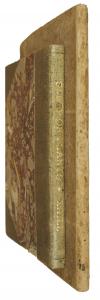The Sleep of Plants, and cause of motion in the sensitive plant. In a letter to C. Linnaeus.
Eur 2,500 / USD 2,800
The price shown on each item does not include V.A.T (Value Added Tax). As a result of the recent EU legislation we are required to charge our EU customers the percentage of V.A.T. charged by the customer’s country of residence, unless they possess a V.A.T. registration number. Postage Additional.
London, R. Baldwin, 1757. 8vo (150 x 95mm). pp. (10), 57, (3). Recent half calf, gilt lettered spine, marbled sides. (Together with:) HILL, J. Abhandlung von dem Schlaf der Pflanzen, und der Ursache der Bewegung der empfindenden Pflanze, in einem Sendschreiben an den Schwedischen Ritter von Linné; übersetzt, und mit einigen Anmerkungen erläutert, von Heinrich Johann von Hahn. Carlsruhe, bey Michael Macklott, 1776. 8vo (190 x120mm). pp. (8), 83, with 1 engraved folded plate and 12 woodcut vignettes. Contemporary boards, uncut.
Hill's 'Sleep of plants?' is generally considered his most important contribution in the field of vegetable physiology
Rare first edition together with the first German edition, with a plate, only present in the German edition. "The phenomenon of ?plant sleep? ? whereby vegetables rhythmically open and close their leaves or petals in daily cycles ? has been a continual source of fascination for those with botanical interests, from the Portuguese physician Cristóbal Acosta and the Italian naturalist Prospero Alpini in the sixteenth century to Percy Bysshe Shelley and Charles Darwin in the nineteenth. But it was in 1757 that the topic received its earliest systemic treatment on English shores with the prodigious author, botanist, actor, and Royal Society critic John Hill?s The Sleep of Plants, and Cause of Motion in the Sensitive Plant... Hill and his respondents used this remarkable behaviour, exhibited by certain plants, as a lens through which to reassess the nature of vegetables, and to address pressing questions of wider natural philosophical import, particularly the degree of continuity between the structures and functions of plants and animals and whether similar mechanisms necessarily account for related movements in different life forms. These disputes, this paper contends, also had profound methodological implications regarding the proper way to conduct experiments, the extent to which it was acceptable to extrapolate from observations, and the status of causal explanations" (J. Begley. Ann. of Science vol. 78,1).
"Hill's 'Sleep of plants? is generally considered his most important contribution in the field of vegetable physiology. This short treatise, dedicated to the King, is written in a form of letter to Linnaeus, dated 7 September 1757. It was published as a result of a series of experiments performed by Hill, on Mimosa pudica, or the sensitive plant, and Abrus precatorius, which showed that the alteration of light and darkness was the cause of the movements connected with the so-called sleep of plants. This treatise?. Appeared also in foreign editions" (Henry. British Botanical and Horticultural Literature before 1800 Vol. II p. 101).
Pritzel 4064.





